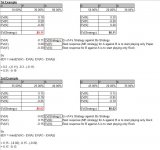R
rhombus
Legend
Silver Level
To give an example how to calculate dEV, I made a simple spreadsheet to quickly calculate EVs in Roshambo . Suppose we don't know what the optimal strategy pair for this game looks like so we take a guess (rock%, paper%, scissors%):
A: (10, 30, 60)
B: (50, 20, 30)
1) EV of A's strategy against B's strategy is: EV(A) = -$0.11
2) Best response (ME strategy) for A against B is to start playing only Paper (becuse B plays rock "too much"): EV(A') = $0.20
3) Best response for B against A is to start playing only Rock (because A plays Scissors a lot): EV(A'') = -$0.30
dEV = $0.33 (it's the longer distance from those ME strategies to the original one: dEV = max(EV(A') - EV(A); EV(A'') - EV(A))). Next guess:
A: (35, 25, 40)
B: (45, 20, 35)
1) EV(A) = -$0.02
2) EV(A') = $0.10
3) EV(A'') = -$0.15
dEV = $0.13 -> it's closer to dEV = 0 then the previous guess so...we are closer to Equilibrium
not sure how dEV works
you say dEV = max(EV(A') - EV(A); EV(A'') - EV(A))) whats the ; in the equation
also wasnt sure about the second part after the semi colon EV(A'') - EV(A)))
1st one 1st part of equation
dEV = max(EV(A') - EV(A)
0.20 - (-0.11) = $0.31
2nd one
dEV = max(EV(A') - EV(A)
= .15 - (0.02) = $0.17



